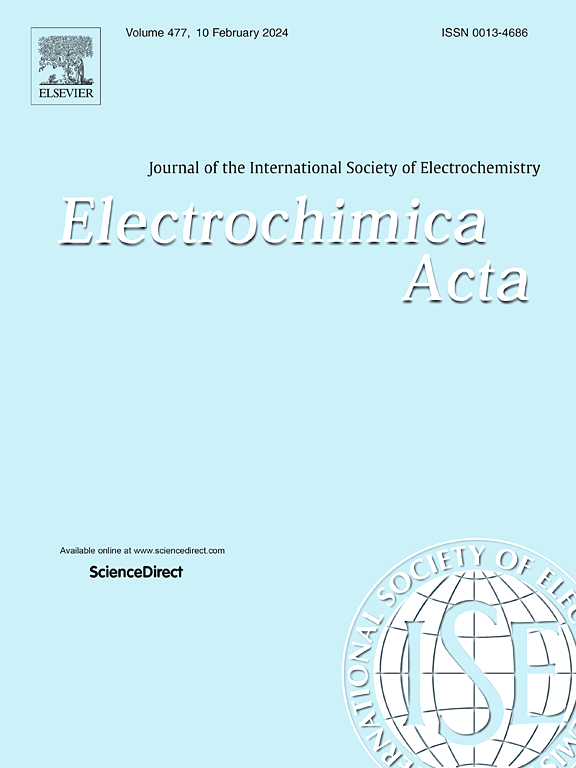含perimidin- Perinone体系的共价键:14h -苯并[4,5]异醌[2,1- A]perimidin-14-one的电位氧化研究
IF 5.5
3区 材料科学
Q1 ELECTROCHEMISTRY
引用次数: 0
摘要
近年来,我们的研究主要集中在培酮基单体的氧化加成/偶联反应上,其中的反应发生在培酮段之间。到目前为止,我们已经使用了相当复杂和双官能的异吲哚-[2,1-a]和异喹啉-[2,1-a]类环嘧啶酮,这导致固体产物难以分析。这些研究的主要目的是提出简单的、单功能的嘧啶单体,并通过表征它们的可溶性电氧化产物来评价它们的反应性。参考化合物是不含环嘧啶的结构类似物,但来源于相同的酸酐,即11h -异吲哚[2,1-a]苯并咪唑-11-on(1,2-苯并亚苯并咪唑)(A1)和7h -苯并咪唑[2,1-a]苯并咪唑[de]异喹啉-7-one(1,8-萘-1 ',2 ' -苯并咪唑)(A2)。本文研究了12h -异吲哚-[2,1-a]perimidin-12-one(12-邻苯二甲酸二酮)(B1)和14h -苯并[4,5]异喹啉-[2,1-a] perimidin-14-one(萘thaloperinone) (B2)的电氧化反应,比较了它们的氧化活性,并定义了双邻苯二甲酸键。A系列氧化后未形成电活性物质,而B系列则成功形成导电层,说明嘧啶单元具有氧化加成的能力。而B2电偶联工艺效率最高。质谱(MS)、量子化学计算、紫外-可见-近红外(UV-Vis-NIR)和ESR光谱电化学分析对B2的溶解和固体电氧化产物(分别为1pFr和2pB2)进行了分析,发现存在多种产物,包括单键去质子化双嘧啶二聚体,特别是在1pFr部分。我们认为,特定的分子间相互作用更多地促进了单链二聚体的合适取向,并通过其随后在交变电位下的氧化使其从半阶梯结构(1pB2)转变为阶梯结构(2pB2)。电动力学氧化过程的条件决定了某些二聚体的去质子化和放电。然而,在某些情况下,由于氢键的稳定,键仍然是质子化的,这是由于羰基的邻近。固体产物2pB2的多重氧化还原性质与不同二聚体的混合物的存在有关:一键或二键,也有质子二聚体。我们的研究结果提供了新的见解,在组间的佩里酮化合物的键合机制,突出了他们的潜力,通过电化学方法合成一类新的有机化合物。本文章由计算机程序翻译,如有差异,请以英文原文为准。
![Covalent bonding in perimidine-containing perinone systems: a case study using potentiodynamic oxidation of 14H-benzo[4,5]isoquino[2,1-a]perimidin-14-one](https://img.booksci.cn/booksciimg/2025-4/101302832041774867976.jpg)
![Covalent bonding in perimidine-containing perinone systems: a case study using potentiodynamic oxidation of 14H-benzo[4,5]isoquino[2,1-a]perimidin-14-one](https://img.booksci.cn/booksciimg/2025-4/2025040810251401565615.png)
Covalent bonding in perimidine-containing perinone systems: a case study using potentiodynamic oxidation of 14H-benzo[4,5]isoquino[2,1-a]perimidin-14-one
In recent years, we have focused our research on the oxidative addition/coupling of monomers from the perinone group, where the reaction occurs between perimidine segments. So far, we have used rather complex and difunctional isoidolo-[2,1-a]perimidinones and isoquino-[2,1-a]perimidinones, which resulted in solid products that were difficult to analyze. The primary objective of these studies was to propose simple, monofunctional perimidine monomers and evaluate their reactivity through the characterization of their soluble electrooxidation products. The reference compounds were structural analogues lacking perimidine, yet derived from the same anhydrides, i.e. 11H-isoindolo[2,1-a]benzimidazole-11-on (1,2-benzoylenebenzimidazole) (A1), and 7H-benzimidazo[2,1-a]benzo[de]isoquinolin-7-one (1,8-naphthoylene-1′,2′-benzimidazole) (A2). In this work we investigated the electrooxidation of 12H-isoindolo-[2,1-a]perimidin-12-one (12-phthaloperinone) (B1) and 14H-benzo[4,5]isoquinolino[2,1-a]perimidin-14-one (naphthaloperinone) (B2) to compare their oxidative reactivity and define the bis-perimidine bonding. While the A series did not form electroactive material after oxidation, the B series successfully formed the conductive layer, indicating that perimidine unit is capable of oxidative addition. However, the B2 electrocoupling process was characterized by the best efficiency. Mass spectrometry (MS), quantum chemical calculations, as well as UV–Vis-NIR and ESR spectroelectrochemistry analyses of the dissolved and solid electrooxidation products of B2 (i.e. 1pFr, 2pB2, respectively) revealed the presence of multiple products, including one-bonded deprotonated bis-perimidine dimers, especially in 1pFr fraction. We propose that specific intermolecular interactions more promote the suitable orientation of the singly-linked dimer and by its subsequent oxidation under alternating potential giving transition from the semi-ladder (1pB2) to the ladder structure presented by 2pB2. The conditions of the electrodynamic oxidation process determine the deprotonation and discharge of some dimers. However, in certain cases, the bonds remain protonated due to stabilization by hydrogen bonds, which arises from the proximity of the carbonyl group. The multiredox nature of the solid product 2pB2 is related to the presence of a mixture of different dimers: one- or two-bonded, and also protonated dimers. Our findings offer new insights into the mechanisms of perimidine bonding within group of perinone compunds, highlighting their potential for synthesising a novel class of organic compounds through electrochemical methods.
求助全文
通过发布文献求助,成功后即可免费获取论文全文。
去求助
来源期刊

Electrochimica Acta
工程技术-电化学
CiteScore
11.30
自引率
6.10%
发文量
1634
审稿时长
41 days
期刊介绍:
Electrochimica Acta is an international journal. It is intended for the publication of both original work and reviews in the field of electrochemistry. Electrochemistry should be interpreted to mean any of the research fields covered by the Divisions of the International Society of Electrochemistry listed below, as well as emerging scientific domains covered by ISE New Topics Committee.
 求助内容:
求助内容: 应助结果提醒方式:
应助结果提醒方式:


